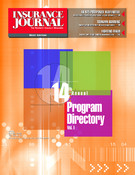The American Insurance Association commended Sen. Christopher Dodd (D-Connecticut) and Sen. John Warner (R-Virginia) for their sponsorship of S. 795, the National Graduated Driver Licensing (GDL) Incentive Grant Program. A GDL system phases young beginners into full driving privileges as they mature and develop driving skills.
In order to qualify for a federal grant, the bill would require states to have a three-stage licensing process that also includes a prohibition on nighttime driving during the learner’s and intermediate stages and a prohibition during those stages against more than one non-family member passenger in the vehicle unless there is a licensed driver at least 21 years old present.
“In 2002, teen drivers constituted only 6.4 percent of all drivers, but were involved in 14.3 percent of all fatal motor vehicle crashes,” stated Melissa Shelk, AIA vice president, federal affairs. “Injuries from vehicle crashes are by far the leading public health problem for young people 13-19 years old.”
Traditionally, states have required beginning teenage drivers to have very little experience before obtaining licenses that let them drive when and where they wanted. In 1995, only 30 states required a learner’s permit, and only 11 required the permit to be held for a minimum period, ranging from 14 to 90 days. That is changing as more and more states are implementing graduated licensing programs.
“Teenage drivers have very high rates of both fatal and nonfatal crashes compared with drivers of other ages. Immaturity and lack of driving experience are the main reasons,” Shelk explained. “Compared with older drivers, teenagers as a group are more willing to take risks and less likely to use seat belts. They also are more likely than older drivers to underestimate the dangers associated with hazardous situations.”
Forty-one percent of teenage motor vehicle deaths in 2002 occurred between 9 p.m. and 6 a.m. Studies show nighttime driving restrictions are associated with crash reductions of up to 60 percent during restricted hours. The purpose of night driving restrictions is to protect young beginners by keeping them from driving unsupervised during high-risk nighttime hours.
“The majority of nighttime crashes occur in the hours before midnight, which is when more young people are out on the roads. Therefore, nighttime driving restrictions should begin several hours before midnight,” said David Snyder, AIA vice president and assistant general counsel.
“As part of a graduated licensing system, the Insurance Institute for Highway Safety (IIHS) recommends that young beginners be encouraged to gain nighttime driving experience, but with adult supervision rather than with peers,” Snyder said.
The prohibition of carrying more than one non-family member in the vehicle is crucial, because studies clearly show that the presence of teenage passengers in the car of beginning teenage drivers increases the risk of crashing compared with driving alone; the more teenage passengers, the greater the risk.
Increased risk with passengers present is thought to be largely the result of distraction and risk-taking factors. In vehicles with other occupants, there is often considerable verbal interaction, music playing, and sometimes physical interactions. At the beginning stages of driving, inattentiveness to the task can have serious consequences.
Was this article valuable?
Here are more articles you may enjoy.


 Former Congressman Charged After Collision with State Trooper in Florida
Former Congressman Charged After Collision with State Trooper in Florida  North Carolina Adjuster and Son Charged With Embezzlement in Roof Jobs
North Carolina Adjuster and Son Charged With Embezzlement in Roof Jobs  Dubai Floods Expose Weaknesses to a Rapidly Changing Climate
Dubai Floods Expose Weaknesses to a Rapidly Changing Climate  FBI Says Chinese Hackers Preparing to Attack US Infrastructure
FBI Says Chinese Hackers Preparing to Attack US Infrastructure 


